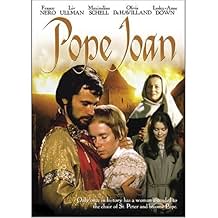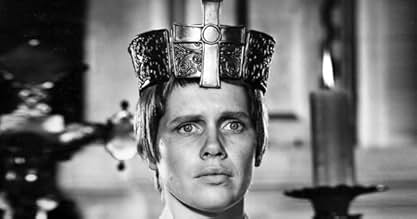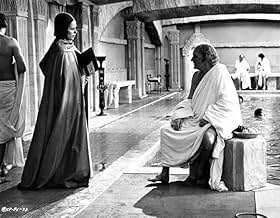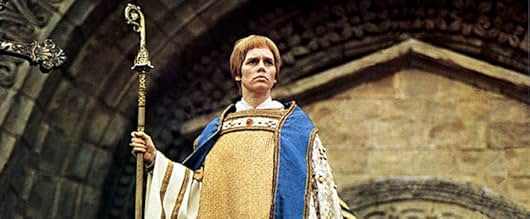Agrega una trama en tu idiomaIn medieval Europe, a pious young woman becomes a scholar of theology, disguises herself as a man, rises through the Catholic Church hierarchy and is elected Pope.In medieval Europe, a pious young woman becomes a scholar of theology, disguises herself as a man, rises through the Catholic Church hierarchy and is elected Pope.In medieval Europe, a pious young woman becomes a scholar of theology, disguises herself as a man, rises through the Catholic Church hierarchy and is elected Pope.
- Dirección
- Guionista
- Elenco
- Dirección
- Guionista
- Todo el elenco y el equipo
- Producción, taquilla y más en IMDbPro
Opiniones destacadas
There is a novel (Pope Joan/ I Papissa Iwanna) by Greek writer Emmanouil Roidis (1836-1904). It's written at the language of those times. Papissa means a woman Pope. Only now there are women in churches. Writer lived at Syros (Ermoupolis). There were many Catholics in that Greek island. This novel was not loved by church... And the writer was a blasphemy for the church exactly for this reason. The film's story is relative to this novel? John Briley knew Roidis' novel? IMDb's review don't say anything about this. If someone knows about it, please write... You can see about the novel and the writer in internet. There 're many relative sites. I 'm waiting for any answers about this. Thank you!
I saw the film on TV, quite by chance. I found the film gripping: the story, the atmosphere and the historical detail.
I have no religious interest, but it made me curious to find out more about 'pope Joan'. The film is a work of fiction based on a legend, with very little factual basis.
Nevertheless, one could really get a sense of life in those times (9th century Europe). Poverty, illiteracy, corruption. The place of women. The violence, that life was worth very little.
Sadly, I think much of the world is just like that today, so perhaps it is a little window on humanity.
I have no religious interest, but it made me curious to find out more about 'pope Joan'. The film is a work of fiction based on a legend, with very little factual basis.
Nevertheless, one could really get a sense of life in those times (9th century Europe). Poverty, illiteracy, corruption. The place of women. The violence, that life was worth very little.
Sadly, I think much of the world is just like that today, so perhaps it is a little window on humanity.
The early 1970's was my favourite period in recent cinema history, classics such as Kubrick's Clockwork Orange, Skolimowsky's Deep End and Visconti's Death in Venice abound; but there are some, less than ringing endorsements of the era, this half-forgotten movie being one.
Liv Ullman, the embodiment of Scandinavian sang-froid, the epitome of ephemeral solemnity, plays Joan, a pious and youthful nun, who travels from a medieval convent, burnt down by Saxons, raping and pillaging, as if they misconstrued it for a set on a Ken Russell film, to Rome where disguised as a (rather attractive) young man, she wins her spurs, becomes a cardinal and eventually the first - and possibly last - female pope.
The trouble is, although Liv's performance is full of meaning and her fights against the alleged sin of lust, particularly enthralling, the editing, jumpiness and preposterousness of some scenes, leave an anxious viewer in need of redemption elsewhere.
True, it is interesting to see actors of the time - Lesley Anne Down, Maximillian Schell, Trevor Howard and Olivia de Havilland - giving robust performances, but a sandwich with an attractive filling is hardly worth eating if the bread is stale. And this is a stale mish mash, which ultimately fails to satisfy. It is a shame. The theme is interesting, whether the story is true or not. Given the current arguments amongst many religions on the role of women, it has significance for us in the 21st Century.
The scenery around Brasov, Romania, where it was filmed, which I visited post Ceausescu, is exemplary. Mind you, maybe the reason for the film's disjointed nature is just that - that the dictator, in his first flush of dictatorial youth, was in charge of production. There again, maybe Ceausescu was a woman. Now that would be a tale worth telling...
Liv Ullman, the embodiment of Scandinavian sang-froid, the epitome of ephemeral solemnity, plays Joan, a pious and youthful nun, who travels from a medieval convent, burnt down by Saxons, raping and pillaging, as if they misconstrued it for a set on a Ken Russell film, to Rome where disguised as a (rather attractive) young man, she wins her spurs, becomes a cardinal and eventually the first - and possibly last - female pope.
The trouble is, although Liv's performance is full of meaning and her fights against the alleged sin of lust, particularly enthralling, the editing, jumpiness and preposterousness of some scenes, leave an anxious viewer in need of redemption elsewhere.
True, it is interesting to see actors of the time - Lesley Anne Down, Maximillian Schell, Trevor Howard and Olivia de Havilland - giving robust performances, but a sandwich with an attractive filling is hardly worth eating if the bread is stale. And this is a stale mish mash, which ultimately fails to satisfy. It is a shame. The theme is interesting, whether the story is true or not. Given the current arguments amongst many religions on the role of women, it has significance for us in the 21st Century.
The scenery around Brasov, Romania, where it was filmed, which I visited post Ceausescu, is exemplary. Mind you, maybe the reason for the film's disjointed nature is just that - that the dictator, in his first flush of dictatorial youth, was in charge of production. There again, maybe Ceausescu was a woman. Now that would be a tale worth telling...
"What a surprise! Not only the story, but what a cast! Liv Ullmann, Trevor Howard, Olivia de Havilland, Maximilian Schell, Franco Nero, Leslie Ann Down! And the texture of the movie - the crude medieval villages, the halls of the ancient Vatican, the incredible 10th Century nunnery, the countryside of Saxon Germany, in peace and war, scene after scene that could never have been shot in Hollywood. But the greatest discovery is the performance of Liv Ullmann. If anything ever deserved an Academy Award. She creates more passion and sexual desire with her eyes and the movement of a hand than the whole pantheon of current sex goddesses could with all their bodies and a ravishing musical score behind them. And when it comes to tragedy and fear those same eyes dig so deeply into the soul they leave a mark that haunts you for weeks. This is a wonderful, wonderful picture."
Costume drama based on popular legend about a 9th century nun who disguised herself as a man and--after some rather innocent deception--became Cardinal in Rome and later Pope before her secret was discovered. Panned by professional critics in 1972, "Pope Joan" was re-edited by nervous executives resulting in a picture that nobody was happy with. Still, despite the mangling, the performances come through, most especially Liv Ullmann's, excellent in the complex leading role. Supporting cast also fine, including Maximilian Schell (very sexy as a randy monk), Olivia de Havilland, Lesley-Anne Down, Patrick Magee, Franco Nero and Trevor Howard. Adequately filmed in London substituting for Italy, and worth a look for the curious. **1/2 from ****
¿Sabías que…?
- TriviaAfter a muted critical response, the film was severely re-edited. In its original incarnation, the film contained many flashbacks and flash-forwards, quite a progressive style for 1972. These were all removed to create a more linear story and the film was then released as "The Devil's Imposter". These changes were reinstated for a 2009 reissue.
- Versiones alternativasIn the version shown on BBC TV on 22nd October 2005, the 20th-century bookend scenes are cut, Keir Dullea and Robert Beatty do not appear, and the film ends abruptly with the crowd descending on Joan.
- ConexionesFeatured in A Quiet Revolution (1972)
Selecciones populares
Inicia sesión para calificar y agrega a la lista de videos para obtener recomendaciones personalizadas
- How long is Pope Joan?Con tecnología de Alexa
Detalles
- Fecha de lanzamiento
- País de origen
- Idioma
- También se conoce como
- The Devil's Imposter
- Locaciones de filmación
- Brasov, Rumanía(mountain top castle scenes)
- Productoras
- Ver más créditos de la compañía en IMDbPro
- Tiempo de ejecución2 horas 12 minutos
- Mezcla de sonido
- Relación de aspecto
- 2.35 : 1
Contribuir a esta página
Sugiere una edición o agrega el contenido que falta

Principales brechas de datos
By what name was Pope Joan (1972) officially released in India in English?
Responda




























